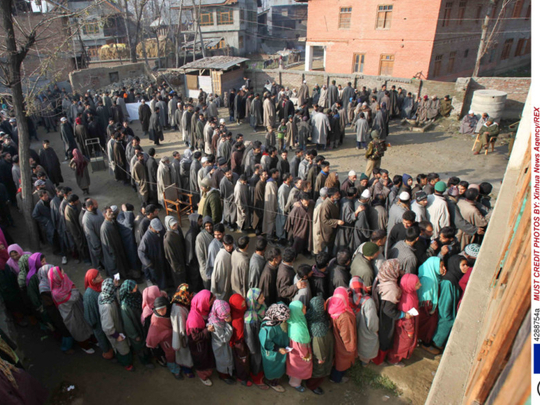
Dubai: In Bollywood director Vishal Bharadwaj’s recent, critically-acclaimed offering Haider, the protagonist, immaculately portrayed by Shahid Kapoor, creates one of the most poignant moments in the film as he indulges in a subtle wordplay with ‘Afspa’ (Armed Forces Special Powers Act), contrasting it with the term ‘chutzpah’ (quality of audacity — for good or for bad).
The coming together of Bharatiya Janata Party (BJP) and the Jammu and Kashmir Peoples Democratic Party (PDP) to form a coalition government in the state is no less than a ‘chutzpah’ moment — not only for an average Kashmiri, but for the macrocosm of Indian politics as well.
In the 67 years since the nation’s independence and the maturing of the Union under a multiparty democratic order, scarcely has there been an occasion when two political entities vacillating between such extremes in terms of their DNA have joined hands for the sake of governance.
The formation of the BJP-PDP coalition government in J&K last Sunday — after two months of political impasse and governor’s rule, following a fractured verdict in the state assembly polls last November-December — marks a watershed moment in India’s political history. And while the presence of Prime Minister Narendra Modi added a whole new dimension to the swearing-in ceremony in the state’s winter capital of Jammu, Chief Minister Mufti Mohammad Sayeed rose to the occasion, terming the new chemistry between the two parties as “politics of confluence, not convenience”.
No less significant is the fact that erstwhile separatist leader and Peoples Conference chairman Sajjad Lone decided to join the new government as a coalition partner and has even been inducted in Sayeed’s cabinet as a minister — a first of sorts for a state where the writ of the bullet is known to have run roughshod over the power of the ballot for decades, periodic elections notwithstanding.
Tale of malleability
Lone joining the political fold in itself is a fascinating tale of malleability, whereby a democratic will got the better of a hard-line ideology soaked up in the dream of “azaadi” (independence). Lone, whose wife Asma is a Pakistan national and whose brother Bilal Lone is a leader of the hard-line Hurriyat Conference, has absolutely no qualms about being a part of the political mainstream and a coalition that features a party like the BJP whose rigid stance on revoking Article 370 — that grants special status to Jammu and Kashmir under the Constitution of India — had rendered it politically untouchable in the state until the other day.
“Ideology has its place, but ideology should not be an impediment to development. And having had one meeting with Prime Minister Modi, I must say that it is very difficult for anyone to come out of that room without being impressed by what that man has to say about his development agenda,” Lone told Indian news channel NDTV after the swearing-in.
It was this issue of development that was the mainstay of the BJP campaign. While each and every rally Modi addressed in the J&K drew large crowds, the five-phase election saw huge turnouts, particularly in the first, second and fifth phases when polling was over 70 per cent — something unthinkable in a state where exercising one’s franchise itself was a dalliance with danger as elections in the past had turned out to be happy hunting grounds for militants. In that sense, the assembly polls this time around saw relatively less blood spilt in the valley.
Commenting on the decline in violence in recent months, new CM Sayeed said: “I want to say this on record and I have told this to the prime minister that we must credit the Hurriyat and militant outfits for the conduct of assembly elections in the state.” Sayeed in fact went a step further and even extolled the role of Pakistan in helping ensure voters in the state could come out in their numbers to exercise their democratic rights. He thanked “people from across the border” for maintaining a “conducive atmosphere” during the elections — a comment that drew flak from a section of political observers and former CM, Omar Abdullah, who even mocked at the BJP leadership in a tweet, saying: “BJP ministers swearing allegiance to the same constitution of J & K that Shyama Prasad Mukherjee [sic] died trying to get rid of.” Shyama Prasad Mookerjee was the founder of Jan Sangh — the political outfit that gave birth to BJP in later years — who died under detention in 1953 over seeking a complete integration of J&K with the rest of the Indian Union, thereby revoking the special status granted to the state.
Compromises
Sayeed was candid enough in acknowledging the anomalies of such a coupling, calling it “the coming together of North Pole and South Pole”! And it has come with compromises on either side. While BJP has agreed to soft-pedal its demand over abolition of Article 370, PDP too has promised not to be insistent on the discontinuation of Afspa. But the moot point is, this new political arithmetic has given the people of the state enough reason to seek a recalibration in terms of the more rudimentary demands of everyday existence — better infrastructure, better education, better employment opportunities, better health services and most of all, a sustainable peace.
When Sajjad’s wife Asma was asked whether she had any reservations about her husband meeting Modi, the Pakistani woman drew an allusion to Nawaz Sharif attending Modi’s swearing-in in New Delhi last May and said something on these lines: “If my prime minister has no problems attending the Indian prime minister’s swearing-in, then why should I have a problem with my husband meeting Modi.”
That’s the new discourse emerging from the state right now — a discourse that is not dictated by the rigidity of age-old allegiances to formulaic treatment of truth, but based on an honest acceptance of reality tinged by a reassessment of pragmatics.
And the monochromatic, sepia cinemascope of Afspa has indeed made room for a 70mm, high-definition chutzpah.













